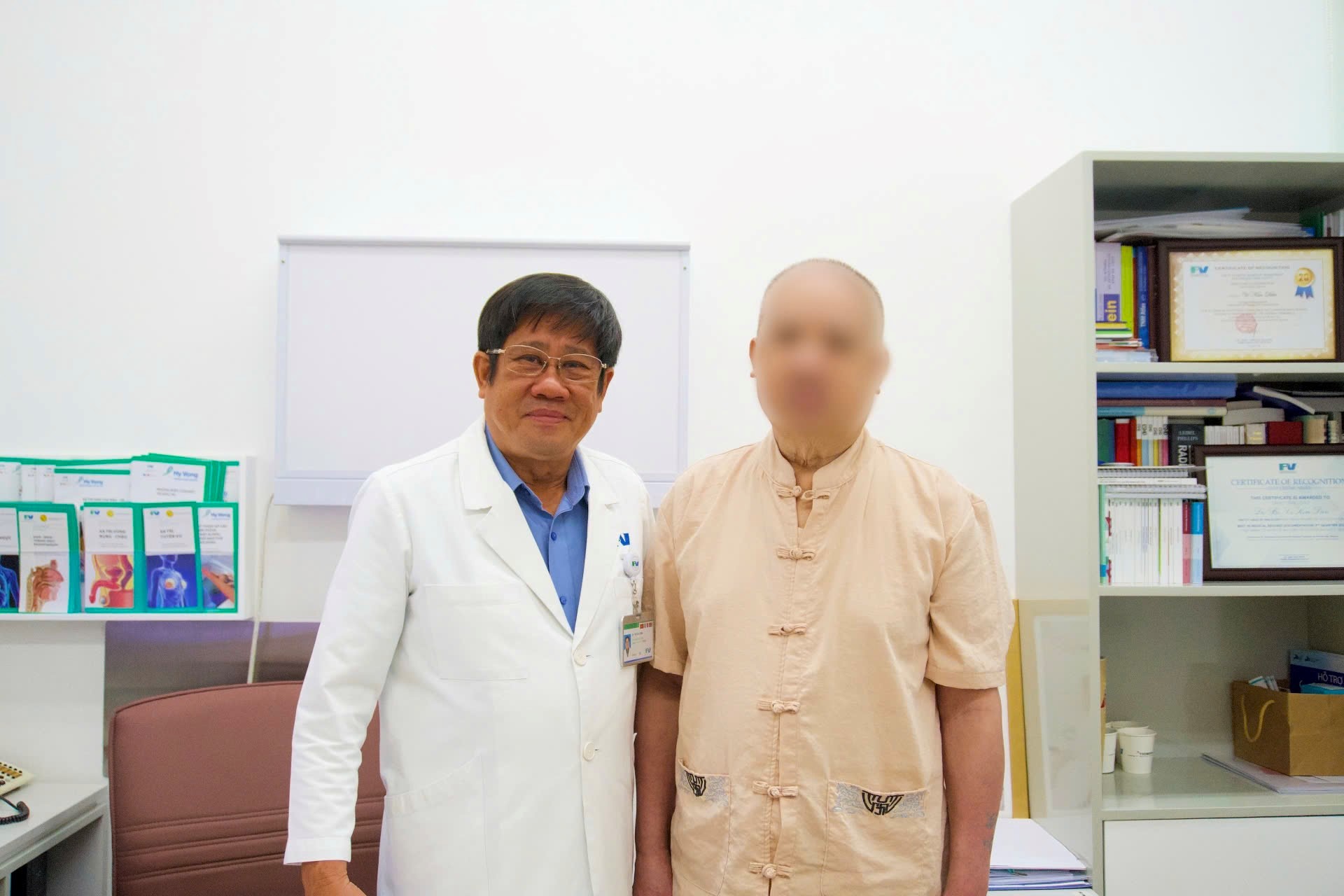Mr. H.G.T, a 69-year-old patient in Ho Chi Minh City, was diagnosed with Gastrointestinal Stromal Tumor (GIST) during the emergency treatment at FV Hospital. After two years of using targeted therapy, Mr. T. was fortunate to return to a normal life.
His family is delighted as finding the correct diagnosis and receiving treatment at the right place gave him a second chance at life.
Almost succumbing after two incorrect diagnoses
In May 2021, after a routine health check-up at a private hospital, Mr. H.G.T was shocked when receiving the diagnosis of prostate cancer. After undergoing chemotherapy for some time, his condition worsened significantly.
His family sought treatment at another hospital, where doctors diagnosed him with adrenal gland cancer that had metastasized to the liver. He underwent chemotherapy again, but once more, his body did not respond, and his condition deteriorated, leading to significant blood loss. Due to prolonged anemia, he frequently required blood transfusions.

In August 2022, Mr. T.’s condition worsened. His family rushed him to FV Hospital, holding out a fragile hope.
From the examination results, Dr. Vo Kim Dien from Hy Vong Cancer Center noted that Mr. T. had severe anemia. A normal blood count ranges from 12.5 to 17.5, but Mr. T.’s was only between 7-8, and at times, it dropped to 5-6. Suspecting gastrointestinal bleeding, the doctor recommended imaging and endoscopy for a more accurate assessment.
“The imaging results showed that the patient’s prostate was normal. However, upon reviewing the images, I discovered a significant lesion at the end of the esophagus, typical of GIST (Gastrointestinal Stromal Tumors), measuring 90mm. Cancer had metastasized to the liver, with metastatic tumors reaching 120mm,” Dr. Dien explained.
In addition, Mr. T. had gastric mucosal bleeding and chronic kidney failure, which were also contributing to the anemia, requiring frequent emergency care.
The digestive tract is shaped like a muscular tube, with an inner mucosal layer, a submucosal layer beneath it, and muscular rings on the outside. According to Dr. Dien, most gastrointestinal cancers arise from cells in the mucosal layer, while GIST tumors originate in the submucosal layer or the muscle layers, making diagnosis challenging and often leading to incorrect treatment.
Targeted therapy: Shrinking the GIST tumor without surgery
With the experience in treating GIST, Dr. Vo Kim Dien explained that if cancer has not metastasized, surgery is the treatment of choice. However, in Mr. T.’s case, as the cancer had already spread, surgery was not an option, so targeted therapy was prescribed instead.
“Targeted therapy specifically targets tumor cells, attacking the cancerous cells while causing minimal harm to healthy cells. Although this type of medication is not new, it remains the optimal choice for treating GIST,” Dr. Dien said.

From August 2022, Mr. T. began daily targeted therapy and regular follow-up visits. His health gradually improved, showing that his body was responding well to the treatment. He was also monitored by a nephrologist to manage his chronic kidney disease. After two years, follow-up imaging revealed that the 90mm esophageal tumor had shrunk to 15mm, and the liver tumor had reduced from 120mm to 49mm. Mr. T. continues using the medication to control the tumor.
During a follow-up visit to FV, Mr. T. happily shared that his health had significantly improved. His daughter, Ms. H.T.P.T. expressed: “At previous hospitals, the incorrect diagnosis and treatment weakened my father’s body further. FV diagnosed the condition correctly and treated him well. When my father was admitted to FV in an emergency, he was in a critical state, unable to move. Now, he can live a normal life. It’s truly like a second chance at life!”
Signs to help detect GIST
According to annual statistics in the U.S., there are 4,000-6,000 GIST cases, with 60% occurring in the stomach and about 30% in the small intestine. GIST in the esophagus like Mr. T. is very rare, accounting for only 0.7%.

GISTs develop silently, and symptoms such as difficulty swallowing typically only appear when the tumor has grown large. If the tumor is located in the mucosal layer, difficulty swallowing may occur earlier, while if it is located beneath the mucosa, symptoms may appear later.
“If detected early, when the tumor is still localized, the five years survival rate is as high as 93%. However, if the tumor has spread to other organs, the five years survival rate drops to 55%,” Dr. Dien noted. He also advised people to seek medical attention if they experience symptoms such as difficult swallowing, nausea, vomiting, general weakness, unexplained long-term anemia, or bleeding.
For treatment of GIST or other types of cancer, you can contact Hy Vong Cancer Center at FV Hospital at (028) 54 11 33 33.









